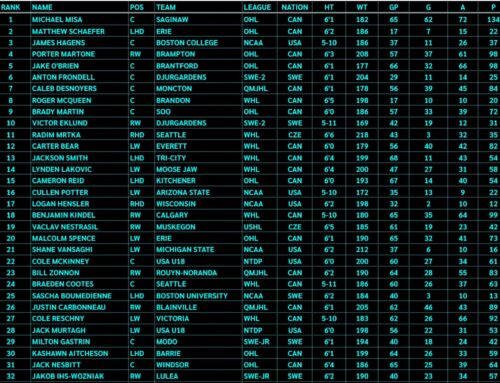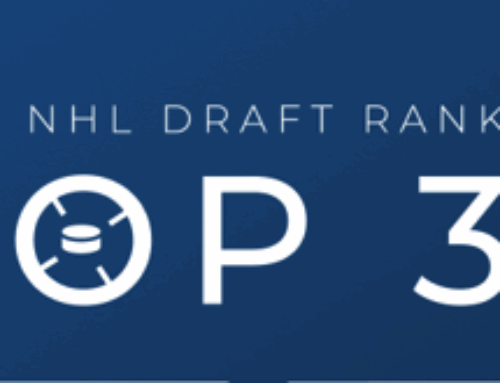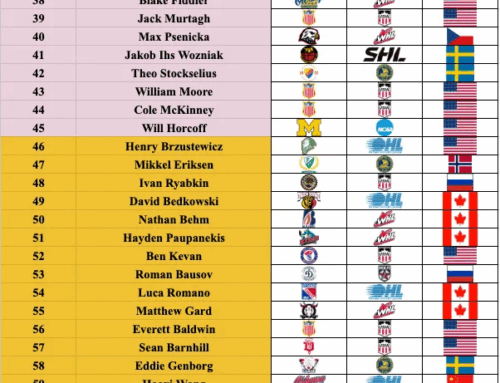AHL Report: May 2018
Brayden Olafson
2018-05-08

Brayden Olafson breaks out the math in this month’ AHL Report
***
We’re quickly nearing the end of the hockey season – playoffs in most leagues are still going strong, but if you’re anything like me, you’re already starting to get anxious about drafting again.
As I mentioned above, this month, I really brought out the spreadsheets and got into some figures. Disclaimer, I’m not a satiation – hell, I just found out this month that there are actually two different ways to calculate standard deviation in excel… If you care what the difference is, it’s here <https://support.office.com/en-us/article/stdev-s-function-7d69cf97-0c1f-4acf-be27-f3e83904cc23>.
The question I kept asking myself was this, “Sure, it looks like there are a ton of great prospects in the AHL this year, but how many of them are REALLY going to be worth owning?” How many of these players should I really try to convince all of you readers you should be drafting? Well, today folks, I hope to answer that, or if nothing else make the answer just a little bit clearer.
The first thing that I did was define my parameters. What actually makes a player a relevant “own “in a points-only league?
Well, first let’s suppose a 12 team league featuring 15 active skaters and a minimum of 4 defenders. That would give us 48 defensemen. The 48th highest scoring defender in the NHL this year, Ryan Ellis scored 32 points, which seems typical, so to give us some leeway from year-year we’ll set the cut-off for “relevancy” at 30 points. As for forwards in that same league, we’d be looking at the 96th highest scoring forward – Sam Reinhart who had exactly 50 points. Since there’s a little higher standard deviation with forwards, we’ll be generous and set the cut-off at 40 points.
Now the question is, “How many former AHL forwards manage 40 NHL points in their first year removed from the minor-pro league, and how many defenders manage 30?” To make the numbers manageable, I narrowed the window of what we call a “former AHL player” to a player who was featured in a minimum of 30 AHL games the prior season. Since the 2010-11 season there are exactly 22 players who fit in that window.
Not a single one of those players was over the age of 26 when they broke out, and the only ones older than 23 were Anders Lee (2014), Mike Hoffman (2014), and Yanni Gourde (2017). The average age of a player to have this magnitude of a breakout from the AHL was almost exactly 22 years old, with a very narrow standard deviation of 1.46 years. This means, once a player turns 24, his chances of breaking out in his rookie NHL season are significantly reduced. With that in mind, we’ve just discussed three key exceptions who have all become significant fantasy presences. They’re just that though, exceptions. For this exercise we really want keep things as consistent as possible, and in turn making our predictions that much more reliable.
The next question, “In each of those players’ prior seasons that they played in the AHL, how did they do?” After all, those are the numbers that a lot of us are currently looking into for our draft lists. This answer is a little less concrete than the age factor, however not totally open ended. The year prior to his 39 point rookie campaign in the NHL, Brady Skjei only scored 28 points in 68 AHL games – a lower scoring rate in the lesser of the two leagues just a summer earlier. Sure, development plays a part in this, but that again is an exception. On average, between forwards and defensemen, in the year prior to their NHL breakout those 22 players scored at a rate of 0.80 points per game, give-or-take a standard deviation of 0.22 points per game. So there, every AHL player to score 0.58 points per game this year WILL break out next year. Er… Not so fast I guess. How many other players in that age range do you think ALSO made that impact in the AHL? On average, 44 AHL players under the age of 24-years-old scored better than 0.7 points per game each year… EACH YEAR! Meaning a measly 6% of them “broke-out” into the NHL the following year (the standard deviation was high on this, in 2015 0% of those players “broke-out”, and in 2010 19% did). Now eventually, more will. A 40-point rookie season is truly exceptional, but around 45% of those players can be expected to eventually be fantasy relevant, that number also seems to be increasing. Since 2013, around half of AHL players under the age of 24 who score more than 0.7 points per game will become fantasy-relevant in the NHL, not bad.
We’re not done yet though, the most important question of the day, “Which ones are going to make a go of it next?!” Well, unfortunately, as far as I can tell, this is where is comes down to a bit more guess work and intuition. We have our parameters of what is realistic, but in narrowing it down, several other intangible factors will come into play, for example, quality of a player’s opportunity, coachability, and as I opened the year talking about, CBA/contract details. Based on our blanket parameters, we can assume that no more than 4 of our 30 “eligible” players (6% average + 6% standard deviation) will have break-out seasons next year, with not much more than 16 of them (46% average + 8% standard deviation) eventually becoming relevant fantasy property. My picks for the 4 AHLers to break-out in the NHL next season are as follows:
Dylan Strome | Tucson Roadrunners | 21-years-old
It will be at least three years since his draft that Dylan Strome will become an NHL regular, and while some have lost hope in the 6-3 pivot, the Coyote’s couldn’t be happier to add him to their offense. Skating has held him back to this point in his career, however, a season in the AHL has helped Strome to improve on that somewhat, as well as learn to play more to his strengths to produce offense. The 53-point scoring AHLer will look to take the next step once again, this time with slightly lower expectations, and slightly more confidence. He’ll be sheltered by a stronger defense than the Coyotes have had in the past, as well as a mentor up front, in Derek Stepan.
Daniel Sprong | Wilkes-Barre/Scranton Penguins | 21-years-old
The former Charlottetown Islander has been patient through his unique development path in the Penguins system. Pittsburgh’s current top-6 forwards are actually shuffled throughout their entire lineup, allowing for an aggregate of skill to be distributed evenly. Sprong has made significant strides in the AHL this season, driving offense on his own in WBS. Certainly the Pen’s can find a spot for him alongside one or two of their superstars.
Anthony Cirelli | Syracuse Crunch | 20-years-old
In the final month we caught a short glimpse of what Cirelli is capable of providing at the NHL level. Even now we are seeing how his 180-foot style of play allows him to remain effective in a rough and tough NHL playoff series. The Lightning are already making room for him so there should be no doubt that a top-9 job will be his to loose next fall when Kunitz is off the books.
Nikolay Goldobin | Utica Comets | 22-years-old
With the dearly-departed Henrik and Daniel leaving a significant vacuum in the Canucks rebuilding roster, we should expect a heavy youth infusion in Vancouver. Goldobin has already proven he is capable of contributing in the NHL, but with more favorable minutes becoming available in the lineup, Goldobin could be a darkhorse for offensive success amongst a lineup that will certainly have sexier names.
I’d have highlighted Valentin Zykov if it weren’t for the uncertainty in Carolina. Bill Peters seemed to trust the kid, and had put him in a position to succeed. It’s tough to know for sure if he’ll get that opportunity under the new head coach. Other dark horse picks include Daniel O’Regan, Andreas Johnsson, Nicholas Merkley, Sami Niku and Jack Roslovic. Those are the names you might want to consider drafting in your 1-year leagues. I think each of them could make a case for a 30 or 40 point season depending on whether they’re a forward or defenseman, and given the right opportunity. Hopefully your one-year leagues wait until after some training camp has gone by, and we’ll have a better idea of if they’ll be given that opportunity this season. In your keeper league’s, most of those guys are probably already snapped up, if not, draft them as if they’ve got 45/65 point upsides as defensemen and forwards respectively.
On top of those 11 players who could potentially make an NHL impact next season, I would put my money on the remaining 5 eventually relevant players being Rudolfs Balcers, Mason Appleton, Mathieu Joseph, Andrew Mangiapane, and Rasmus Andersson… and maybe 6, Sammy Blais. These are the guys to look for in the depth of your keeper leagues, either by way of the draft, or the waiver wire. Each of them has a respectable upside that should result in them making relevant contributions to your fantasy squad within a year or two. To answer the big question from above, I wouldn’t draft much deeper than your top 15 ranked AHL players, obviously depending on the depth of your league.
An interesting tid-bit from my research – draft position had almost zero impact on the probability of a player having a successful transition from the AHL. In fact, several late or undrafted players turned out to have as much or more success as soon as first-round-picks. Mark Stone (178th overall) and Ondrej Palat (208th overall) both broke out at the age of 22 with 59 and 64 points respectively. In contrast, Logan Couture and Filip Forsberg, who broke out at the age of 21 and 20, scored 56 and 63 points respectively. It could be argued that some of the higher picks still have higher ceilings, but throughout the sample size, it appears to be pretty balanced. It seems once everyone is on the same playing field, the past doesn’t mean much at all.
Another interesting bit of information, of the 22 players in question, 6 had played in the NCAA prior to the AHL, 6 in the WHL, 5 in the OHL, 3 in the QMJHL, and only 1 from each the ECHL and Sweden’s Allsvenskan. NCAA players that leave school early seem to be a relatively safe bet to break out after some AHL development.
I hope you’ll forgive me if there were some numbers that were overlooked. I’m still fairly new compiling a large amount of numbers in a short period of time. If anyone knows of a place where more advanced stats for lesser leagues are available, I’d love to hear.
***
In current AHL news, the Toronto Marlies have handled the Syracuse Crunch to this point in their best-of-7 series. The Marlies lead the series 3-games to 2 and have an opportunity for the sweep on Tuesday in Syracuse. Their veteran-led victory on Sunday night was by a 6-goal margin, embarrassing rookie goaltender Connor Ingram with 7 goals on 30 shots.
One of the leagues’ strongest teams in the Manitoba Moose continue to struggle these playoffs, now versus Chicago’s farm team in Rockford. They’ll need stronger goaltending out of Eric Comrie, and for their potent offense to show up on Wednesday night if they want to make a series of it. Lesser-hyped of the two Sikura brother, Tyler, has been a force for the Icehogs. While the statement may come a little late in his development, a brotherly-chemistry could eventually land him a few games in the NHL.
Lehigh Valley remain tied with Charlotte at a game-a-piece, as do the Tucson Roadrunners and Texas Stars. Charlotte’s potent young forwards dismantled the Phantoms back end on Saturday night, burying 6 goals on Dustin Tokarski over a measly 23-shots. The Phantom’s offense failed to score a single goal on Alex Nedeljkovic. Game-3 will go Tuesday night in Charlotte. With Texas gaining the upper hand after splitting Tucson’s two home-games, they’ll continue to look to veteran goaltender Mike McKenna who has been outstanding in the playoffs, allowing only 3 goals on 69 shots by the dangerous Roadrunners offense. Tucson’s win in game-1 also came in overtime, making the series look as though it’s closer than it really is.
***
Find me on Twitter @olaf1393 for all of your AHL & Tampa Bay Prospect fixin’s
LATEST PROFILE UPDATES
LATEST RADIO & DRAFTCASTS
2 Comments
Leave A Comment
You must be logged in to post a comment.







Totally on board, great article and breakdown, predictive AHL stats are a hell of a rodeo. The only other thought that comes to mind for me is the number of chances an AHL prospect has already had (number of games played in the NHL already); for instance Goldobin has already played 61 games…in terms of the guys you listed, I would discount his potential versus Sprong and Strome who both have had less than half the opportunity (26 and 28 games respectively). There must be a cut off at some point where a prospects chances of producing drop off after a certain number of chances/NHL games…one example that comes to mind is Andrighetto who had perennial PPG numbers in the AHL but in 100+ games in the NHL is not over 0.4PPG and yes he is 25 now but in 2015/16 after his 44 game debut could we have significantly downgraded his fantasy potential??? Loved this article.
Just to follow up, both Hoffman and Gourde played less than 30 NHL games prior to their 1st successful NHL campaign while putting up their stud AHL numbers…maybe its less age and more so opportunity?? Pure speculation but interesting to me.